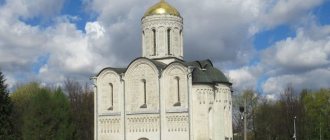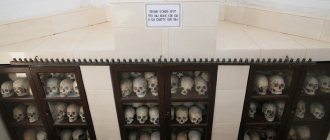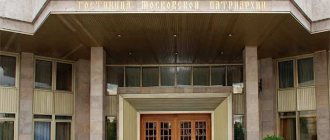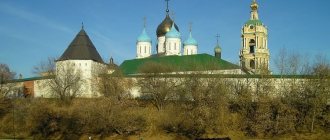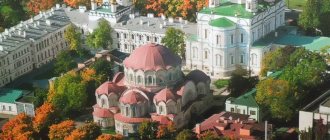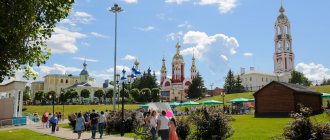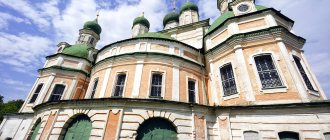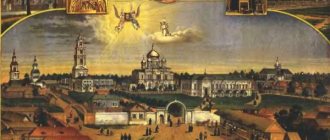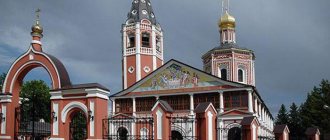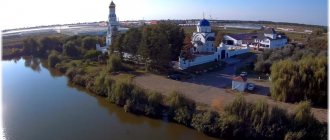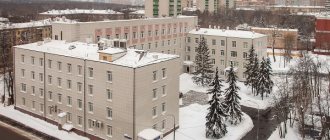Located in the very heart of old Moscow, the Mother of God Nativity Monastery is one of the oldest convents for women in Russia. Founded at the end of the 14th century and an integral part of the capital for more than six centuries, the monastery gave its name to the two streets at the intersection of which it is located - Rozhdestvensky Boulevard and Rozhdestvenka.
Monastery address: Moscow, Rozhdestvenka street, 20.
Having gone through the crucible of difficult trials in the 20th century, together with the entire Russian Orthodox Church, and revived during the years of perestroika, today it is one of the leading spiritual centers of the country.
The vow made by Princess Maria
Researchers do not have a consensus on where the Nativity Monastery was originally founded in Moscow, but they all agree that this important event in the history of the capital is associated with the name of Princess Maria Konstantinovna, the mother of the hero of the Battle of Kulikovo, Prince Vladimir the Brave. She made a vow (if her son returned alive from the battlefield) to found a monastery in honor of the Queen of Heaven. Having fulfilled her promise and built the monastery, the princess, according to legend, took monastic vows there with the name Martha.
Venerable Euthymius and Saint Martha - mother of Simeon the Stylite
It is worth saying a few words about the rare saints to whom the chapels of the church in Obraztsovo are dedicated. Saint Euthymius the Great was born in the city of Melitina near the Euphrates River and from early childhood was raised in the family of his uncle, a Christian presbyter. The young man’s piety was noted by the local bishop Eutropius, who made him a church reader. Over time, the bishop ordained Euthymius to the priesthood, but the young ascetic was burdened by life in the world. At the age of 29, he secretly fled to Jerusalem and settled in a cave near one of the laurels. Here Euthymius met the desert dweller Theoktist, with whom he then lived inseparably and shared his hermitic exploits.
Five years later, two ascetics changed their habitat and moved to a steep mountain overgrown with forest. There they lived in complete solitude, eating grass and plants. One day, the forest dwelling of Euthymius and Theoktista was accidentally discovered by shepherds. They spread the news about the holy monks throughout the area, and from then on people began to come to the forest monastery every day.
Among the visitors to Saint Euthymius was the chief of the Saracens, Terevon. The noble young man fell seriously ill and, having tried all the remedies of doctors and healers, in his last hope he went to the monk’s cell. Euthymius prayed over the sick man, made the sign of the cross, and the disease subsided. Terevon, his father and the Saracens who were with him, seeing this miracle, accepted holy baptism and became Christians. From then on, a continuous stream of sick people were brought to the monk for healing. In search of greater solitude, Euthymius hid on Mount Marda near the Dead Sea, and then in the Ziph desert. Finally, Euthymius settled next to his friend Theoktist on another mountain, where he founded a monastery famous in that era. The Monk Euthymius performed miracles and healings and converted many pagans to the Christian faith. Euthymius the Great died at the age of 97 in 437 AD.
Saint Martha was the mother of Saint Simeon, the first known stylite in the history of Christian monasticism. The Monk Simeon already at the age of 18 took monastic vows, but sought extreme feats: he wrapped himself in a rope so that it dug deep into his body, lived at the bottom of a dry well, and tested himself by refusing food for forty days. Finally, Saint Simeon came up with a new type of asceticism - he built a tower-pillar and placed a hut about a meter high on it. The pillar grew taller every year until it finally reached a height of 16 meters!
One day the devil decided to tempt the saint. He appeared to him in the form of an angel on a fiery chariot, saying that he had come to take him alive to heaven, like the prophet Elijah. Saint Simeon believed these flattering words and already raised his right foot to step into the chariot, but he recognized the deception when he made the sign of the cross. The devil in the guise of an angel instantly disappeared, and the saint, as a sign of repentance, decided to stand motionless for a whole year on one leg - the same one that almost stepped into the chariot.
The Monk Simeon received visitors, reconciled those who quarreled, convinced heretics to renounce their errors, and healed illnesses, all the while being on his tower. He died as a centenarian, having spent about 80 years of his life on the pillar. On the site of the monk’s unusual dwelling, a church was subsequently built, and then a monastery. About his mother Martha, it is known that she died 30 years earlier in 428 at the pillar of her son.
The dedications of the thrones of the church in Obraztsovo recall different periods of the ancient history of the village. The main chapel of the Nativity of the Virgin Mary referred to the first wooden church in the Khabarovs' estate, the chapel of St. Euthymius the Great belonged to the almost two-century period when the village was owned by the Spaso-Evfimiev Monastery in Suzdal, and the third chapel of St. Martha (the namesake holy wife of the temple builder Count Platon Ivanovich Musin-Pushkin) pointed to the era of the Musins-Pushkins.
Disputes in the scientific world
In general, this version of events does not meet with objections, but there are disputes over where exactly the monastery was founded. According to one version, it was originally located within the Kremlin and was moved to its current location a century later - already during the reign of Grand Duke Ivan III.
However, many historians adhere to the version according to which the Nativity Monastery (Moscow) was founded exactly where it is located today. Their opinion is based on the fact that at the end of the 14th century these lands belonged to the hero of the Battle of Kulikovo himself - Prince Vladimir the Brave, and his mother, the founder of the monastery, lived here in a wooden palace that belonged to her. In addition, in the monastery cathedral there are the graves of two daughters-in-law of Prince Dmitry Donskoy - Elena and Maria. This also suggests that the monastery was here long before the reign of Ivan III.
The Nativity Monastery, which still operates in Moscow to this day, is a kind of monument to the victory of the Russians in the Battle of Kulikovo, and there are several reasons for this. In addition to the fact that it was founded by the mother of one of the main characters of this event, its first nuns were the widows of the participants in the battle. A shelter was created there for everyone who lost their breadwinners - husbands, sons and brothers - in the battle with Mamai.
Monastery of strict rules
According to the surviving data, among the three women's monasteries operating at that time in Moscow, the Nativity Monastery stood out for the special strictness of the cenobitic charter adopted in it and its complete independence from the actions taken by the abbots of the monasteries. The status of the women's monastery did not at all prohibit male monks from visiting its walls. Thus, it is known that in the 90s of the 14th century it briefly became the refuge of St. Kirill of Belozersky.
Princess Maria Konstantinovna, who died a few years after the Nativity Convent was founded in Moscow, took monastic vows there shortly before her death and was buried under the altar of the main church. Her daughter-in-law, the wife of Prince Vladimir the Brave, Elena Olgerdovna, bequeathed her lands near Moscow to the monastery, which included the famous Holy Lake, with which, according to legend, the founding of Moscow is connected.
According to the chronicle, in 1500 Moscow was engulfed in a terrible fire, which often happened in an era when almost all its buildings were wooden. The Nativity Monastery was also destroyed by fire. It was restored on the personal orders of Grand Duke Ivan III, who ordered the construction of a new stone cathedral in it. Its consecration, carried out in 1505, became, as it were, the result of the life of the prince, who died shortly after that.
Temple builders Musins-Pushkins
Since 1701, the history of the Mother of God Nativity parish has been closely connected with the new owners of the village of Obraztsovo, Ivan Alekseevich Musin-Pushkin and his son Platon Ivanovich. On January 24, 1701, Count Ivan Alekseevich Musin-Pushkin was placed by Tsar Peter I at the head of a special department - the Monastic Prikaz. Instead of a salary, the count was given the village of Obraztsovo, which before that, as stated above, belonged to the Spaso-Evfimiev Monastery. This transfer was initially temporary, but in 1710 the count was able to obtain from the tsar full ownership of the village of Obraztsovo. The Spaso-Evfimiev Monastery tried to challenge this decision, taking advantage of the fact that the count soon fell out of favor with the tsar, but in the end the estate still remained with Musin-Pushkin, which was confirmed by a new charter in 1722.
In 1730, Obraztsovo was inherited by the son of Ivan Alekseevich Musin-Pushkin, Platon Ivanovich, who built the current stone church. Father and son Musina-Pushkin left behind a good memory as temple builders. By their order, several stone churches were erected in the Moscow region: in 1725, the Trinity (Borisoglebskaya) in Ramenskoye, in 1728, the Nativity of John the Baptist in the village of Novorozhdestveno (not preserved), in 1737 churches were consecrated in the village of Glazov (not preserved) and the village Goretov, Mozhaisk district.
In 1733, Platon Ivanovich Musin-Pushkin began building a stone church in the village of Obraztsovo. The new temple retained the ancient dedication to the Nativity of the Mother of God and the chapel of St. Euthymius the Great, but the temple builder also wanted to add a second chapel - in honor of St. Martha, mother of Simeon the Stylite. A rare saint was the heavenly patroness of Platon Ivanovich’s wife, Marfa Fedorovna Khomyakova.
The stone Church of the Nativity of the Virgin Mary was built in 1736, and just 4 years later Count Platon Ivanovich Musin-Pushkin was put on trial for conspiracy against Empress Anna Ioannovna. Artemy Volynsky, an opponent of the Bironovism, was appointed the main conspirator. On June 23, 1740, three leaders of the conspiracy were executed, and Count Musin-Pushkin, as one of the “confidants,” was deprived of all estates and exiled to the Solovetsky Monastery. The count, however, did not stay in northern exile for long: in December of the same 1740, he was allowed to return and live in one of his villages in Mozhaisk district. One way or another, Obraztsovo was never returned to the Musin-Pushkins.
Tombstone of Nikolai Petrovich Kisel-Zagoryansky
Since 1740, after the arrest of Musin-Pushkin, the estate passed to Alexei Petrovich-Bestuzhev Ryumin, then to his son Andrei and nephews Alexei and Mikhail Volkonsky. In the 19th century, Obraztsov was also owned by the merchants Meshchaninovs and Lyapins, and the last owners of the village before the 1917 revolution were the nobles Kisel-Zagoryansky. The magnificent tombstone of Major Nikolai Petrovich Kisel-Zagoryansky in the form of a calvary rock is still preserved in the churchyard of the Church of the Nativity of the Virgin in Obraztsovo. Another interesting tombstone preserved the memory of the persecuted temple builder - John Kuleshevsky, “the faithful servant of the Mosin-Pushkin counts,” is buried to the right of the entrance to the temple, as the text on the gravestone says.
Tombstone of Kuleshevsky “servant of the Mosin-Pushkin counts”
Sin of Grand Duke Vasily III
The Mother of God Nativity Monastery (Moscow) became the scene of many events that went down in Russian history. So, in the fall of 1525, the barren wife of Vasily III, Solomonia Saburova, was forcibly tonsured there as a nun. This flagrant violation of the church charter saved Rus' from civil strife that his brothers could have caused in the absence of an heir.
But the whole people had to pay for the princely sin - the second wife, Elena Glinskaya, gave birth to Ivan the Terrible - an insane tyrant who flooded the country with the blood of innocent victims. By the way, six months later, after his wedding to the kingdom, the monastery burned down for the second time. This time the cause was the largest fire in the history of Moscow in 1547.
The next two centuries in the life of the monastery
Despite its beginning, full of dramatic events, the 17th century turned out to be very favorable for the Mother of God Nativity Convent. It became prestigious in Moscow to live on Rozhdestvenka, and many representatives of the highest nobility moved to this street, which ran past the walls of the monastery. Having become permanent parishioners of the churches, they made generous contributions to the monastery treasury, which made it possible to carry out a large complex of construction work and significantly increased the standard of living of the sisters themselves.
The subsequent 18th century brought significant changes to the economic situation of the monastery. As a result of the secularization of monastic lands carried out by Catherine II, that is, their rejection and transfer to state ownership, the sisters lost all the vast lands donated to them by generous investors. But at the same time, they began to receive government subsidies, which made it possible to compensate for losses to a certain extent.
How to get there
The nearest metro station is Trubnaya. The monastery is located at Rozhdestvenka Street twenty, so you can use public transport or a taxi.
Author of the publication
offline 3 years
Nika
18
I am interested in hiking and traveling, photography and videography. I have been going hiking since childhood. The whole family went and went - sometimes to the sea, then to the river, to the lake, to the forest. There was a time when we spent a whole month in the forest. We lived in tents and cooked over fires. This is probably why I am still drawn to the forest and, in general, to nature. I travel regularly. About three trips a year for 10-15 days and many 2 and 3 day hikes.
Comments: 0Publications: 668Registration: 10/23/2018
Nika Attractions, Articles, Excursion tourism
Napoleonic invasion
The most striking events of the 19th century for the monastery were associated with the Napoleonic invasion. Despite the fact that the French plundered everything that caught their eye, the bulk of the valuables were safely hidden and preserved. The so-called Rostopchin posters were regularly hung on the walls of the monastery - handwritten summaries of military operations, passed off as programs for theatrical performances. They helped protect the population from all sorts of panic rumors and strengthen their faith in the imminent expulsion of the invaders.
At the beginning of the 20th century, large-scale construction work was launched on the territory of the monastery, led by the famous architect F.O. Shekhtel, but after the Bolsheviks seized power, their results were completely erased.
Reborn Shrine
Only in 1993, in the wake of perestroika, the Nativity Monastery was returned to the Church, and after a complex of repair and restoration work was completed, spiritual life resumed in it. Today, three of its churches, consecrated in honor of the Nativity of the Blessed Virgin Mary, the Kazan Icon of the Mother of God and St. John Chrysostom, have been restored and brought back to life. It has become a tradition that every year on the patronal feast day, celebrated on September 21, a patriarchal service is performed in the main church of the monastery.
The monastery runs catechesis courses, as well as a three-year women's singing school. Small parishioners are not forgotten either. They are taught the basics of Orthodoxy on Sundays. But the main attention is paid to liturgical life, in which, along with nuns, numerous parishioners of the Mother of God Monastery of the Nativity (Moscow) also take part.
The schedule of services held there hardly differs from the schedules established in most domestic churches. On weekdays they start at 7:00, and on Sundays at 9:00. Evening prayers, regardless of the day of the week, are held from 17:00.
Architectural monuments
The rectangular area is surrounded by a stone fence with towers. The central place on it is occupied by the ancient Nativity Cathedral, which was built in 1501-1505.
During the restoration work, researchers discovered ancient white stone masonry and came to the conclusion that the cathedral was built on the foundation of an older stone church.
The four-pillar temple is crowned with a tall drum with a helmet-shaped head. Tombstones from the 17th-18th centuries have been preserved in the cathedral refectory. The ancient tomb of the Lobanov-Rostovskys adjoins the building on the south-eastern side.
To the south of the Nativity Cathedral there is a large church of St. John Chrysostom. The first temple on this site was wooden, but in the 1670-1680s it was rebuilt in stone. The warm church was built in the best traditions of posad churches of the 17th century. It has five domes and a spacious refectory. Nowadays, the temple has been well restored and is open to believers.
Bell tower with the Church of Evgeniy Khersonsky
From the north of the Nativity Cathedral you can see a long three-story building, above which rises the five-domed Church of the Kazan Icon of the Mother of God. This church was built at the beginning of the last century by the architect P. A. Vinogradov. The picturesque red brick building is made in the tradition of retrospectivism and is decorated with intricate architraves, columns and flies. During the years of Soviet power, the domes of the temple were demolished, and students from the Moscow Architectural Institute were working inside.
The Church of Evgeniy Khersonsky is located under a three-tiered bell tower, which stands near the entrance gate, from Rozhdestvenka Street. The first temple was built according to the design of the architect N.I. Kozlovsky in the 30s of the 19th century, however, 100 years later, by decision of the authorities, it was destroyed. The church that can be seen today replaced the one that was lost in 2005.
